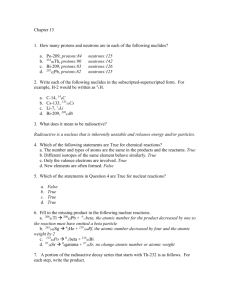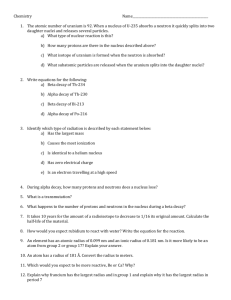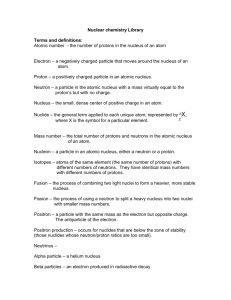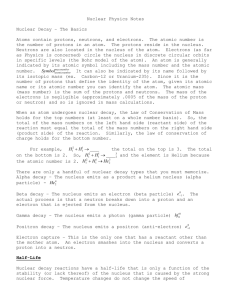Document
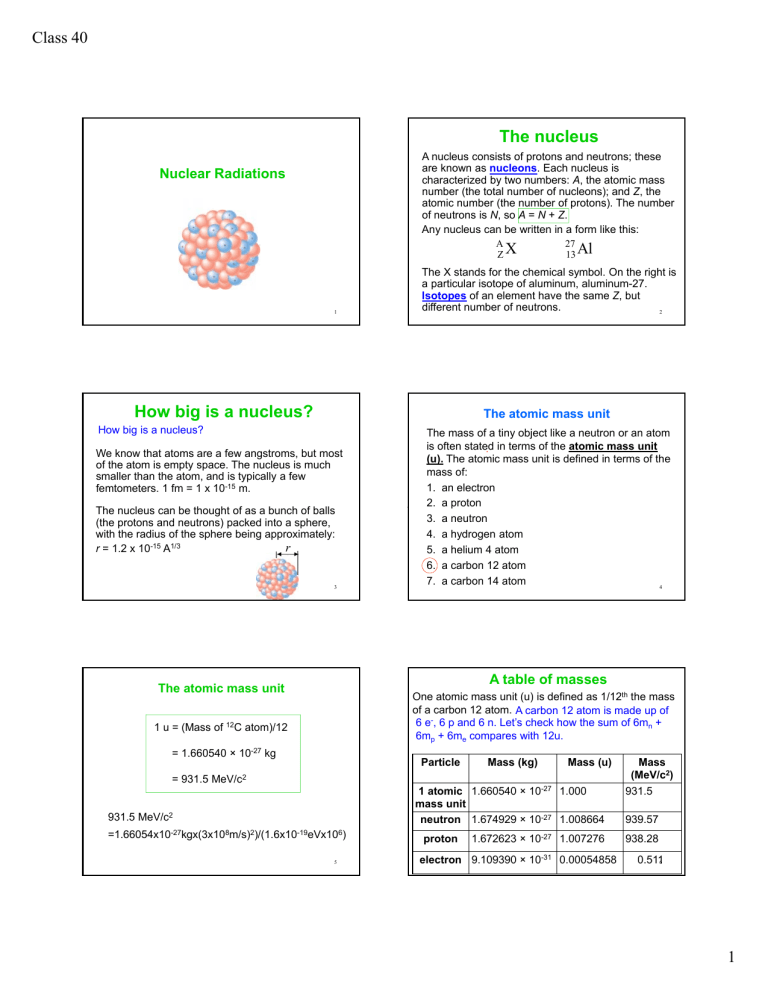
Class 40
Nuclear Radiations
1
The nucleus
A nucleus consists of protons and neutrons; these are known as nucleons . Each nucleus is characterized by two numbers: A , the atomic mass number (the total number of nucleons); and Z , the atomic number (the number of protons). The number of neutrons is N , so A = N + Z .
Any nucleus can be written in a form like this:
A
Z
X 27
13
Al
The X stands for the chemical symbol. On the right is a particular isotope of aluminum, aluminum-27.
Isotopes of an element have the same Z , but different number of neutrons.
2
How big is a nucleus?
How big is a nucleus?
We know that atoms are a few angstroms, but most of the atom is empty space. The nucleus is much smaller than the atom, and is typically a few femtometers. 1 fm = 1 x 10 -15 m.
The nucleus can be thought of as a bunch of balls
(the protons and neutrons) packed into a sphere, with the radius of the sphere being approximately: r = 1.2 x 10 -15 A 1/3 r
3
The atomic mass unit
The mass of a tiny object like a neutron or an atom is often stated in terms of the atomic mass unit
(u).
The atomic mass unit is defined in terms of the mass of:
1. an electron
2. a proton
3. a neutron
4. a hydrogen atom
5. a helium 4 atom
6. a carbon 12 atom
7. a carbon 14 atom
4
The atomic mass unit
1 u = (Mass of 12 C atom)/12
= 1.660540 × 10 -27 kg
= 931.5 MeV/c 2
931.5 MeV/c 2
=1.66054x10
-27 kgx(3x10 8 m/s) 2 )/(1.6x10
-19 eVx10 6 )
5
A table of masses
One atomic mass unit (u) is defined as 1/12 th the mass of a carbon 12 atom. A carbon 12 atom is made up of
6 e
6m
p
, 6 p and 6 n. Let’s check how the sum of 6m
+ 6m e compares with 12u. n
+
Particle Mass (kg) Mass (u)
1 atomic mass unit
1.660540 × 10 -27 1.000
neutron
1.674929 × 10 -27 1.008664
proton 1.672623 × 10 -27 1.007276
electron 9.109390 × 10 -31 0.00054858
Mass
(MeV/c 2 )
931.5
939.57
938.28
1
Class 40
The mass defect
Using the mass data, we can find the sum of masses for 6 neutrons, 6 protons, and 6 electrons:
Sum = 12.098931 u
On the other hand, when these particles are combined into a carbon-12 atom, the atom has a mass of precisely 12.000000 u. The missing 0.098931 u worth of mass is called the mass defect
.
7
The most famous equation in physics
E
mc
2
The missing mass is the binding energy of the atom
(almost all of that energy is in the nucleus).
By expressing the mass defect in MeV/c 2 (using 1 u
= 931.5 MeV/c 2 ), one gets a direct reading of the binding energy in MeV. For example with carbon-12, the mass defect of 0.098931 u converts to 92.15
MeV/c 2 . This corresponds to a binding energy of
E = (92.15 MeV/c 2 )(c 2 ) = 92.15 MeV.
8
Nuclear processes
In a typical nucleus, the binding energy is measured in MeV, considerably larger than the few eV associated with the binding energy of electrons in an atom. Nuclear processes (such as nuclear reactions or decays) involve changes in the nuclear binding energy. This is why nuclear reactions can give much more energy than chemical reactions, where only changes in electron binding energy are involved.
9
Holding the nucleus together
The nucleus is tiny, so the protons are all very close together. The gravitational force attracting them to each other is much smaller than the electric force repelling them, so there must be another force keeping them together. This other force is known as the strong nuclear force .
The strong nuclear force is a very strong attractive force for protons and neutrons separated by a few femtometers, but it is basically negligible for larger distances.
11
Holding the nucleus together
A typical nucleus has a number of protons and neutrons packed together in a small space. In
PY105 and 106, we had discussed quite a few different kinds of forces. Which of these forces is primarily responsible for holding the nucleus together?
1. gravity
2. tension
3. electrostatic
4. magnetic
5. none of the above
10
The strong force
The tug of war between the attractive strong force and the repulsive electrostatic force between protons has implications for the stability of a nucleus. Atoms with very low atomic numbers have about the same number of neutrons (N) and protons (Z). This is because the nucleus gains stability by having N = Z. As Z gets larger, there is more electrostatic repulsion so large nuclei need more neutrons (which increases the strong force without adding electrostatic repulsion) than protons for stability.
Eventually, a point is reached beyond which there are no stable nuclei. The bismuth nucleus with 83 protons and 126 neutrons is the largest stable nucleus.
Unstable nuclei undergo radioactive decay to transform into more stable daughter nuclei.
12
2
Class 40
Z
Chart of the nuclides http://www.nndc.bnl.gov/chart/ (interactive)
Z=N
isotopes isotones
Chart from Brookhaven
National Laboratory
13
N
Chart of the nuclides
The chart in the last page shows the existing nuclides and their lifetime, where a darker shade represents nuclides with a longer “half-life” (We will discuss what it is shortly). In particular, the nuclides shaded in black have half-life > 30 million years and are so stable.
With increased resolution (found in http://wwwnds.iaea.org/relnsd/vchart/index.html), you will see that for atomic number 0 Z 7, the stable nuclides always have the neutron number, N = Z and/or Z+1. But for Z > 7, the stable nuclides have N increasingly bigger than Z as Z increases. This confirms the general trend discussed on p.
12.
14
Chart of the nuclides
For most unstable nuclides (those not shaded in black on the chart), one can often make pretty accurate prediction about the type of radioactive decay (e.g. , electron capture (EC), + and -. ) they will undertake by merely looking at its position in the chart relative to those of the stable nuclides nearby (see the chart shown on the next page).
In the following, we shall discuss several common kinds of radioactive decays After this lecture, try visit the online chart and check out the radioactive properties of several unstable nuclides at random and see if they exhibit the kind of radioactive decay you expect.
15
Z
N
16
Alpha decay
In alpha decay, the nucleus emits an alpha particle.
An alpha particle is a helium nucleus, 4
2
He (two protons and two neutrons), which is very stable. Alpha particles do not travel far in air before being absorbed.
A
Z
X A-4
Z-2
Y 4
2
He From Wikipedia
According to the Nuclear Shell
Model, a nucleus is more stable when N = Z quantum mechanically.
However, the heavy nuclides have to adopt the N >> Z configuration in the nucleus to enable more nuclear force to counterbalance the Coulomb repulsion of the protons.
17
Alpha decay
If a heavy unstable nuclide A
Z
X is located near a lighter nuclide with atomic number Z 2 and mass number A 4 and a longer half-life, it will undergo alpha decay.
18
3
Class 40
Z
N
19
Alpha decay - an example
An example of alpha decay meeting all these requirements involves Radium 226:
226
88
Ra
222
86
Rn
2
4
He
The product, Radon 222 is a gas in soil and can leak into the basement of homes through cracks in the foundation. Currently, there is a national concern about the health hazards of radon.
20
Alpha decay – another example
238
92
U 234
90
Th 4
2
He
The left side of the equation has more mass (or less mass defect), by 0.004587 u. Where did the extra mass go?
The mass difference was converted to 0.004587 u ×
931.5 MeV/u = 4.273 MeV of energy. This shows up in the kinetic energy of the two atoms after the reaction.
Reactions occur spontaneously when the total mass afterwards is less than the total mass before.
21
Important: General requirements for a permissible radioactive decay
(1) The total mass of the daughter nuclides must be smaller than that of the parents. This is effectively saying that the daughter nuclides are on average more stable than the parent nuclides
(2) The sum of the atomic numbers and mass numbers of all the parent nuclides/particles and daughter nuclides/particles before and after the decay must agree. In checking if this requirement is met, take for neutrons ( 1
0
( 1
1
0 and Z = -1.
n), A = 1 and Z = 0; for protons p), A = 1 and Z = 1; and for electrons ( 0
-1 e), A =
22
Beta decays
In these decays, either a
-minus particle (which is an electron) or a
-plus particle (which is a positron or a positively-charged particle that is the antimatter equivalent of the electron) is emitted.
In terms of safety, beta particles are more penetrating than alpha particles, but less than gamma particles.
23
Beta-minus ( β
-
) decay
Generally,
1
0 n 1
1 p 0 -
-1 e ν e
A
Z
X
Z
A
1
Y
0
1 e
e
For nuclides with N/Z being too large
The particle labeled
e is an antineutrino . The “e” subscript and the over bar denote that it is an electron antineutrino. Notice that it has A=0 (negligible mass) and Z=0 (no charge), and you don’t need to consider it in balancing the total A and Z in the equation. The existence of the neutrino was proposed by Wolfgang
Pauli in 1930 to explain what seemed like violations of the laws of conservation of energy and conservation of momentum in the beta decay process. 24
4
Class 40
Z
N
25
Beta-minus decay – an example
An example of beta decay is:
234
90
Th 234
91
Pa
-1 e ν e
Use the data from the appendix:
The atomic mass of Th 234
The atomic mass of Pa 234
(thorium) is 234.043596 u
(protactinium) is
234.043302 u
We don't have to add the mass of the electron because the mass for Pa 234 includes 91 electrons, which is how many we have on the right side. It's already built into the mass for Pa 234 . The mass of the anti-neutrino is non-zero, but negligible.
26
Beta-plus ( β
+
) decay
1
1 p 1
0 n
+1 e ν e
For nuclides with N/Z being too small
In beta-plus decay, a proton turns into a neutron, a positron, and an electron neutrino. In general, we get:
A
Z
X A
Z-1
Y 0 +
+1 e ν e
27
Z
N
28
Gamma decay
The third class of radioactive decay is gamma decay, in which the nucleus changes from a higherlevel energy nuclear state to a lower level energy state. The nucleus has energy levels, similar to electron levels.
When an electron changes levels, the energy involved is usually a few eV, so a visible or ultraviolet photon is emitted. In the nucleus, energy differences between levels are much larger, typically a few hundred keV, so the photon emitted is a gamma ray.
29
Gamma decay
Gamma rays are very penetrating; they can be most efficiently absorbed by a relatively thick layer of high-density material such as lead.
A gamma decay is written in the following way:
A
Z
X
A
Z
X
For nuclides with an excited nucleon
The asterisk indicates that the nucleus is in an excited state. Note that this is the only kind of radioactive decay in which the atom does not become another element.
30
5
Class 40
Nuclear Fission
A heavy unstable nucleus may split into two more stable daughter nuclei. Through this process, energy is released. An example is the nuclear reaction involving neutron capture of Uranium 235, which is commonly exploited in the production of electricity in a nuclear power plant:
0
1 n
235
92
U
236
92
U
141
56
Ba
92
36
Kr
3
0
1 n
This is one of several reactions that can occur when U 235 fissions upon capturing a neutron.
Alpha decay is a kind of nuclear fission.
31
Nuclear Fusion
An unstable nuclide can fuse with another nuclide
(stable or not) to form a heavier nucleus that is more stable. Most of the energy of the sun comes from fusion reactions. One of the main reactions in the sun involves the fusion of a deuterium and a tritium to liberate a helium and a neutron.
stable
2
1
H
3
1
H
4
2
He
1
0 n
unstable
32
6



